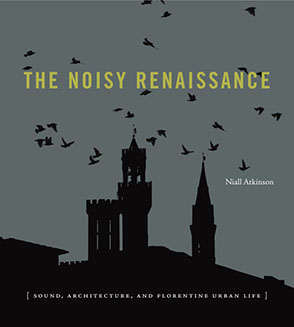


Reviewer Rosa Salzberg - University of Warwick
CitationEveryday life in Italian cities and towns remains a very distinct sensory experience, quite different from most other places in the contemporary Western world. Bells and bell towers continue to make their presence felt, visually and acoustically, and it is no accident that the word campanilismo is still a potent way of describing one’s sense of attachment to a particular place and a delimited community. The true depth and complexity of this heritage is made clear in architectural historian Niall Atkinson’s remarkable study of Renaissance Florence, which builds on recent works in urban history that have sought to recover forgotten elements of the material and physical experience of the pre-modern city. Atkinson’s special focus is the interaction between the ephemeral and the enduring: the ‘dialogue between buildings and bodies’ (p. 1), and particularly between buildings that made sound (bell-towers) and the diverse members of the Florentine populace that heard and saw them. This innovative approach allows the author to revisit familiar aspects of Florentine history and culture and cast them in a wholly fresh light, allowing the reader to see – and, above all, hear – the Renaissance city anew.
Noisy Renaissance begins with a chapter on ‘The Acoustic Art of City-Building’, which lays the foundations for Atkinson’s argument that ‘the sounds that one heard in Florence were as crucial as the sights one saw’ (p. 22) in shaping social and political relations in the city. Particularly effective use, here as elsewhere in the book, is made of popular literary sources such as Antonio Pucci’s poem about the mercato vecchio and the Novelle of Franco Sacchetti, to begin to tease out how Florentines experienced and understood the ‘sonic landscape’ of their city. Atkinson demonstrates the many ways in which sound was used to try to structure and organize public space, even as he also emphasizes what were in reality the ‘fluid topographies’ (p. 62) that criss-crossed this crowded urban environment where people of different classes lived cheek by jowl. This argument is developed further in Chapter Two, ‘Florentine Soundscapes’, which uses extensive maps and illustrations to document how local religious and political authorities constructed bells and bell towers so as to create an ‘integrated acoustic dialogue’ (p. 114); a form of urban planning in which sound was no less important than stone as a means to communicate power, surveillance, protection. Chapter Three, ‘Sound, Space, and Meaning in Renaissance Florence’ adds further depth and nuance to Atkinson’s case for the political and social resonances of the urban soundscape. It investigates how the various bells of the city structured the daily rhythms of life and, in so doing, effectively created space, encompassing Florentines in a larger community or smaller sub-groups of those who could hear the knoll of a certain campanile. Here in particular the author’s vivid writing style and use of a range of suggestive and eclectic sources as well as lavish illustrations and maps work beautifully to evoke elements of the historical urban experience that are usually forgotten.
As powerful as these three opening chapters are, however, more questions might have been asked here about who, exactly, was ‘Florentine’ in this period and how different city-dwellers might have reacted differently to the sounds they heard. For example, one wonders how the many migrants to the city from the countryside or further afield came to understand and navigate Florence’s sonic landscape, or how differences of age and gender might have shaped the acoustic experience. Chapter Four, ‘Suoni, voci, rumori: Listening to the City’ does, however, add more nuance to Atkinson’s depiction of Florentine urban life by turning its attention to less official and regulated forms of communication such as public storytelling and singing. The author’s contribution here continues a rich vein of recent work that has explored the importance of these forms of oral culture in the Renaissance, and makes an important counterpoint to the earlier chapters. Finally, in Chapter Five, ‘Sonic Discord, Urban Disorder’, Atkinson moves from more quotidian experiences to examine a climactic, and well-studied, episode in Florentine history: the famous Ciompi Revolt of 1378. In this, he builds on innovative studies by Trexler and Stella of the mobile and acoustic dimensions of the rebellion but is able to give a fresh interpretation of the dramatic events by investigating further the spatial and sensorial politics in which the Ciompi and their opponents engaged.
Written throughout in elegant and effective prose, Atkinson’s monograph is the work of a truly original thinker and is certain to hold great interest for scholars of Renaissance urban history, architectural history and the history of communication. Florence, which has been the focus of so many important studies, emerges afresh in these pages in all of its boisterous splendour: not just as an assemblage of beautiful, austere, and enduring, buildings, but as a space animated by a diverse and noisy range of actors and by the ephemeral sounds of both everyday life and extraordinary events. While the question remains of how exceptional Florence was as an acoustic (and architectural) environment, this work will encourage its readers to cast a new eye and ear on other Italian cities as well, and on urban sights and sounds that might seem mundane and familiar.